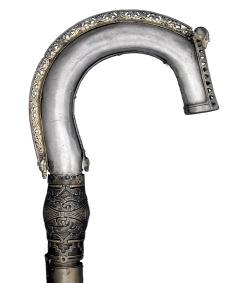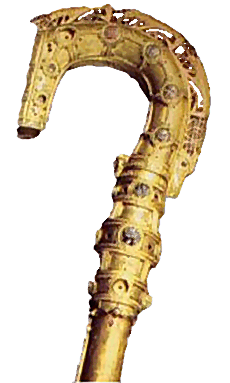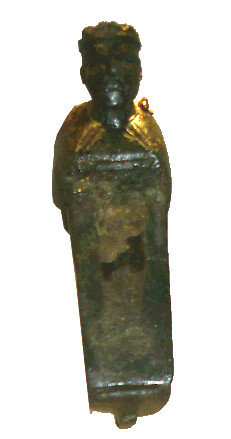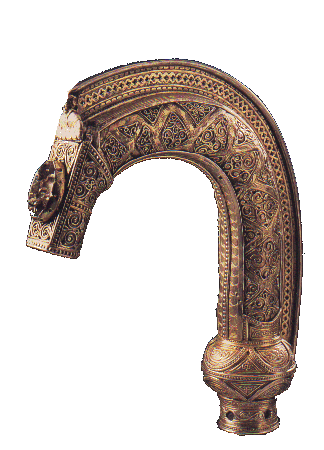![[Clan Crest]](images/Crest%20Colour130.jpg)
Clan MacLea - Livingstone
The Official Home of the Clan McLea (The ancient historical name of the Livingstones)


Croziers of Scots/Irish Celtic Saints
Whilst it is believed that the Bachuil Mor is the one of the oldest surviving croziers of a Celtic saint, and the only one still held by the Coarb, there are examples of other croziers. These are of great interest as it is clear that the Bachuil Mor was once ornamented and it is highly likely that it would have conformed to this pattern.
The Crozier of St Fillan - 8th Century |
|
The Crozier dates from about 730 AD and was kept by heriditary Dewars for over 900yrs |
Oft called the 'quigrich', the pastoral staff, of St Fillan is one of the best preserved and documented. Seen here enclosed in its outer casing of gilt silver. Only the head of the quigrich remains (silver-gilt with a smaller crozier of bronze inclosed within it). St Fillan and arrived at Glendochart around 730 AD from Ireland. Unusually his relics were entrusted to the custody of laymen (hence deòradh Gaelic for stranger) in Glendochart rather than the monks of the priory. The quigrich stayed with the same family of Dewsars in Glendochart for around 900 years until it was sold to the McDonnells of Glengarry. However in time the Dewars' fortunes bought it back eventually being placed in the National Museum of Antiquities in Edinburgh by Alexander Dewar
|
Clonmacnoise Crozier circa 6th Century | |

Image © The National Museum of Ireland. |
In Dublin is this beautiful crozier, the Clonmacnoise crozier. The animal ornamentation on the sides is a version of the mid-eleventh century Scandinavian Ringerike-style which was popularised in Ireland by the Vikings. Although the ornamentation is probably 11th century it is believed the staff is much older and may even have been the Staff of St Ciaran. St. Ciaran was born in about 512 and became a pupil of the legendary St. Finnian. Eventually he founded what was to be become one of Ireland's most flourishing religious communities which survived until 1552 at Clonmacnoise, on the River Shannon in County Meath. Ciaran died in about 545, when the community was only one year old. Unusually the succession to the abbacy at Clonmacnoise was not hereditary - possibly beacuse of his humble origins. Like many Irish saints, Ciaran's life is associated with animals. He told his followers to leave his body on a hilltop "like a stag", as he had little concern for relics and remains. His wish was not fulfilled and his shrine was a place of pilgrimage for centuries. |
The Kells Crozier - 9th-11th Century |
|
 Image © British Museum According to the British Museum website this is believed to come from Ireland, late 9th-11th century AD
Off great interest to Livingstones and those of us from Lismore is that there a silver strip engraved in Irish which asks for a prayer for Cúduilig and Maelfinnén. Now thee was a Cudulig who was Abbot of Lismore in the 12th Century and who was the progenitor of the Macleans. Could this be the same Cuduilig? |
This fine crozier was found without explanation in a solicitor's office in 1850, and was owned by Cardinal Wiseman before purchase by The British Museum in 1859. Originally it would have been venerated as a relic of a saint in the early church in Ireland, and also been a symbol of office for a leading cleric, possibly a bishop or abbot. The appearance of the crozier today is the result of at least two periods of ornamentation as well as early attempts to dismantle or destroy it. The core is a staff of yew wood, now cut in two. This was first encased in bronze in the late ninth or tenth century when the staff was decorated with cast knobs (or ‘knops') and cross-shaped strips. Raised borders divide the knops into panels filled with animal interlace, once covered with bright silver foil. The original bronze casing to the curved crook had a diamond pattern grid and animal ornament. In the eleventh century the crook was given an outer casing of silver sheet and a new crest in gilded openwork of linked birds. A new knop decorated with black niello and silver inlay in the Scandinavian Ringerike style replaced an earlier one at the top of the shaft. The straight end of the crook is a feature of early Irish croziers, and like many others it was altered to form a hollow box with a human head above, to hold a holy relic. On the underside of the crook a silver strip engraved in Irish asks for a prayer for Cúduilig and Maelfinnén who were involved in the refurbishment. Although these names have been identified with individuals who were important at the great Irish monastic city of Kells, County Meath, recent work has questioned this connection. Enshrining items which had belonged to holy men or their communities was an important feature of religious life in early medieval Ireland. Many of these shrines, like St Cuileán's bell, were preserved into modern times by the families of keepers who inherited this duty. |
The Lismore Crozier - 11th Century |
|

Image © The National Museum of Ireland. |
The Lismore Crozier was found hidden in the walls of Lismore Castle in 1814. The inscription states that it was made for Niall Mac Mic Aeducan, Bishop of Lismore, 1090-1113, by Neclan the artist. This certainly ties in with the period of the ornamentation of other croziers of this type. Most of the ornaments are richly gilt, interspersed with others of silver and niello, and bosses of coloured enamels. However it is quite possible that the ornamentation covers the original crozier of St Carthage. St Carthage the Younger, Abbot (also known as Carthach, Mochuda) founded a monastery, known in the Irish Annals as Lismore Mochuda, c635 AD. He was a contemprary of St Moluag even training at Bangor under Saint Comgall - like Moluag - but about thirty years later. Carthage settled for a time at Rahan in Offaly, and in 595 founded a substantial monastery there and ruling over 800 monks. Lismore Mochuda was to become one of the most famous of all Irish monastic schools. One of its students was Saint Cathal, who was elected bishop of Taranto, Italy, during his return from the Holy Land. Saint Carthage was exceptionally strict about the holding of property. Nevertheless, the Lismore Crozier is a treasured item of Irish art - now residing in the National Museum at Dublin. |
The Crozier of St Finan - 7th Century |
|
 |
The Irish-born St Finan was sent from Iona to succeed St Aidan as abbot of Lindisfarne in 651. He worked closely with King Oswy of Northumbria. Among the monarchs baptized by him were King Penda and the English king Sigbert. When Finan died in 661 St Colman, another Irish monk from Iona, succeeded him as abbot of Lindisfarne. It was Colman was destined to become the main speaker for the Celtic Church at the Synod of Whitby in 664 arguing against the Roman Wilfrid. This is only the head - but as in most Irish Croziers of the period it can be seen that it has a hinged lid - suggesting that a saints relic or holy oil was stored in it.
This is now in the Museum of Scotland |
There seems to be a fairly uniform pattern to these croziers.
- The core is a staff of wood often now cut in two.
- These were later covered in bronze, silver gilt or other precious metals.
- They were often decorated with cast knobs (or ‘knops') and cross-shaped strips.
- The straight end of the crook is a feature of many early Irish croziers
and they often had a hollow box to hold a holy relic or possibly
holy oil.
